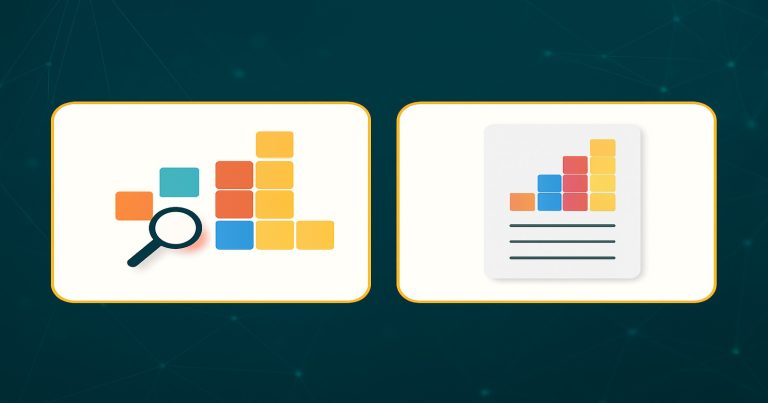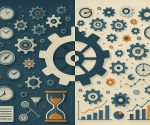Data is the backbone of every analysis, policy, and research study. Whether you’re a student conducting a thesis, a business launching a new product, or a scientist validating an experiment, the type of data you use can directly influence the accuracy, relevance, and reliability. The two main types of data used in research are primary and secondary. While both are essential, they differ significantly in their origin, collection process, cost, and purpose. This comprehensive guide explains everything you need to know about both types—definitions, collection methods, advantages, limitations, and how to choose the right one for your study.
Difference Between Primary Data and Secondary Data
Information is foundational in decision-making, examination, and methodology within commerce, trade inquiry, and insights. In any case, not all information is the same. Understanding the contrast between essential and Secondary data is basic for any undergraduate proficient in investigating, advertising, or scholarly writing.
Primary data alludes to information collected firsthand by the analyst for a particular reason. This sort of information is unique, crude, and natural. It is regularly accumulated through studies, interviews, perceptions, or tests. For instance, if a company needs to know client satisfaction, it might conduct a coordinated survey—this is Primary data.
Secondary data, on the other hand, alludes to pre-existing information collected by somebody else, frequently for a different reason. This will incorporate data from research papers, government reports, daily papers, company records, and online databases. For example, utilizing information from the Census of India or a report distributed by the World Bank is a case of Secondary data utilization.
Both sorts of information have their points of interest and drawbacks, and knowing when to utilize which can influence the quality and unwavering quality of your conclusions. For commerce students, understanding these contrasts is vital for exam preparation, investigating ventures, and practical decision-making.
| Feature | Primary Data | Secondary Data |
| Source | Collected directly by the researcher | Collected by others |
| Purpose | Specific to the current research | Originally for another purpose |
| Cost | High | Low or free |
| Time Requirement | Time-intensive | Time-saving |
| Relevance | Entirely relevant to the study | May not fully match research goals |
| Control | The researcher controls the collection | No control over the collection method |
| Ownership | Exclusive to the researcher | Shared or public |
| Sample Size | Usually small | Often large-scale |
| Data Type | Raw and unprocessed | Cleaned and formatted |
| Update Frequency | Real-time or recent | Could be outdated |
| Usability | Needs effort to collect and analyze | Ready for use |
| Example | Surveys, interviews | Government reports, academic articles |
What is Primary Data?
Primary data alludes to information collected firsthand by an analyst for a particular reason. It is unique, natural, and one of a kind in the inquiry about the matter at hand. This information isn’t already accessible in books, diaries, databases, or reports. It gives analysts precise and custom-fitted data to respond to particular inquiries or test hypotheses. Some characteristics of primary data are as follows:
Inventiveness and Eliteness
Primary data is explicitly collected from the source, guaranteeing that the information is special, bona fide, and has never been used. This exclusivity makes it exceedingly important, particularly for areas where accuracy may be needed, such as clinical trials or client behavior analysis.
Custom-made to Inquire about Needs
Since the analyst chooses what information to gather and how to gather it, the information is adjusted to the study’s objectives. This dispenses with unessential data and increments the productivity and viability of information elucidation.
Illustrations of Primary Data
Primary data incorporates answers from surveys, transcripts from interviews, results from logical tests, and direct field perceptions. These sources give a wealth of context-specific information for examination.
Strategies for Collecting Primary Data
Collecting primary data includes different strategies that depend on the nature of the study, target group of onlookers, and type of data required. Each plan has its own set of instruments, forms, and appropriateness.
Overviews and Surveys
Surveys are widely used apparatuses to assemble quantitative or subjective information from large groups of individuals. These can be organized (with closed-ended questions) or unstructured (with open-ended reactions) and are managed through online stages, emails, phone calls, or face-to-face interactions.
Interviews
Interviews are conducted to get point by point bits of knowledge from people. These can be individual (face-to-face), telephonic, or virtual. Interviews are perfect for collecting in-depth data and understanding emotions, motivations, and suppositions, particularly in social sciences and client involvement research.
Tests
A test inquiry collects information by modifying factors under controlled conditions to observe outcomes. This is often profoundly valuable in logical considerations, such as medicine, psychology, or chemistry, where cause-and-effect connections should be explored.
Coordinate Perceptions
Analysts record occasions or behaviors in real time without affecting the environment. Observational studies are commonly utilized in instructional settings, ethnographic inquiry, and shopper behavior investigation.
Advantages of Primary Data
The use of primary data offers several benefits that contribute to a research project’s overall quality and usefulness. It allows researchers to be deeply involved in the process, ensuring data integrity and precision.
High Relevance and Accuracy
Since the data is collected specifically for the study, it is highly relevant and directly applicable to the research question. There’s no need to filter or rework it, which reduces errors and misinterpretations.
Full Control Over Strategy
Analysts can select the plan, information collection devices, test measures, and target socioeconomics. This control empowers them to guarantee the legitimacy and unwavering quality of the information, tailor it to their needs, and make real-time alterations.
Firsthand Experiences
Primary data gives bits of knowledge directly from the source, such as genuine clients, members, or tests. This first-hand nature of the information lends lavishness and profundity to the discoveries, which is frequently lost in auxiliary sources.
Privacy and Possession
The analyst or organization possesses the information collected, which enables it to select. Usually, especially advantageous in competitive businesses, scholastic research, or intellectual property advancement, where creativity is key.
Limitations of Primary Data
Whereas precise and custom-made to particular inquiries about needs, primary data comes with its own set of impediments. It frequently requires noteworthy time, assets, and effort to gather. Furthermore, respondent inclination and constrained test estimates can influence their generally unwavering quality and scope.
Restrictions of Primary data
Despite its numerous benefits, primary data has a few restrictions that analysts must consider when choosing it as their information source.
Time-Consuming
Planning an inquiry about apparatus, collecting information, cleaning it, and analyzing it can take a few weeks or months. This will be a downside in ventures with strict due dates.
Costly
Contracting information collectors, acquiring tools or overview stages, and overseeing coordinations regularly require a significant financial investment. Typically not perfect for analysts or organizations with constrained budgets.
Gifted Labor Required
Information collection and examination require prepared faculty talented in inquiry about strategy, measurable instruments, and moral honing. Mistakes in the plan or execution can compromise the entire thing.
Sample Size Limitations
Due to time and budget constraints, primary studies often involve smaller samples. While these samples are highly relevant, their limited size can affect generalizability.
What is Secondary Data?
Secondary data is already collected, processed, and possibly published by another person or organization. It was not created for the researcher’s current study, but it can still be helpful for background understanding, trend analysis, or supplementary evidence. Some characteristics of secondary data are as follows:
Already Available
Secondary data exists in public or commercial databases, journals, reports, books, newspapers, and government records. Because it’s already available, it saves researchers time and effort.
Not Particular to the inquiry about
Since secondary data was initially collected for a distinctive reason, it may not perfectly align with the researcher’s current targets. Analysts must assess its pertinence carefully.
Cases of Secondary data
Cases incorporate national census information, monetary reports, distributed research studies, marketing analytics from organizations like Nielsen, and online databases like JSTOR and Statista.
Sources of Secondary Data
Secondary data can be obtained through different sound and widely acknowledged stages. Choosing the proper source depends on your space and data requirements.
Government Distributions.
Governments distribute a wide range of information, including well-being reports, census information, financial studies, labor market insights, and more. These sources are solid and well-documented.
Scholarly Inquiry about & Diaries
Colleges, analysts, and researchers distribute discoveries in peer-reviewed journals and regulatory agencies. These are perfect for building writing surveys and hypothetical systems.
Commercial Showcase: Inquire about Reports
Firms like KPMG, McKinsey, and Gartner frequently release industry-specific information and estimates. Even though a few are paid, they offer profitable experiences in advertising patterns and competitor examination.
Media & Online Databases
Distributions such as daily papers, trade magazines, and curated websites like the World Bank, the IMF, and Google Patterns offer enormous information banks available to the open or for purchase.
Preferences of Secondary Data
Secondary data could be a capable asset, especially for analysts requiring fast, cost-effective data access for exploratory research or setting building.
Saves Time and Resources
Since the data is already collected and organized, researchers can skip the collection phase and go straight to analysis. This speeds up project completion and reduces workload.
Cost-Effective
Most government and academic data is free or available at a very low cost. Even premium databases are often more economical than conducting primary research.
Wide Coverage
Secondary data often covers large samples, regions, or periods that would be difficult or impossible for individual researchers to cover independently.
Useful for Hypothesis Testing
It provides a solid foundation for building hypotheses and testing ideas before investing in a primary study.
Limitations of Secondary Data
Despite its convenience, secondary data is not always the best choice for in-depth or particular research.
Not Tailored to Research
The data may not match the researcher’s specific topic or objectives, leading to gaps in relevance and accuracy.
Quality and Credibility Vary
The data’s usefulness is compromised if the original data collection process is flawed or the source is biased. This can mislead researchers and invalidate conclusions.
May Be Outdated
Many secondary sources are not updated frequently. Using outdated data can skew analysis, especially in fast-moving industries like tech or healthcare.
Limited Customization
Researchers cannot adjust or modify the methodology or variables of the original data, limiting their ability to explore alternative hypotheses.
Primary Data vs Secondary Data FAQs
1. What is the key difference between primary and secondary data?
Primary data is collected firsthand by the researcher for a specific purpose, while secondary data is pre-existing information gathered by others for different research or reporting.
2. Which is more accurate: primary or secondary data?
Primary data is generally more accurate because it’s directly collected and tailored to the current study. However, its quality depends on proper collection methods.
3. When should I use secondary data instead of primary data?
Use secondary data when you need information quickly, have a limited budget, and conduct exploratory or trend analysis, which doesn’t require original data collection.
4. Can both primary and secondary data be used in one research?
Combining both allows for a comprehensive approach—secondary data gives context, while primary data offers specific, real-time insights for deeper analysis.
5. State a few examples of secondary data sources.
Secondary data sources include government reports, academic journals, company financial records, newspapers, and market research databases like Statista or the IMF.


